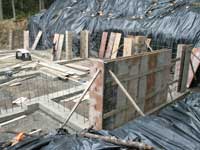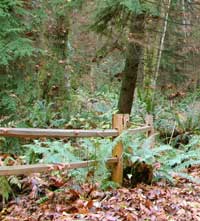HOME

Site Stewardship
An area is clearly delimited to which all construction disturbance is limited. The plastic-covered stockpiles of soil discourage even foot travel beyond this area. The topography is to steep for vehicles to travel off the specified driving area.
At the base of the driveway, where it comes closest to the wetland, a split-rail fence provides added protection to the wetland. Signs have been placed along the established wetland buffer.
Landscaping and Pest Control
After construction, landscaping will emphasize native species and "near-native" species such as cultivars of rhododendron. There will be no lawn. We will scrupulously avoid introducing non-native invasive species, and we actively work to control English ivy and other species that are trying to invade.
We use an "Integrated Pest Management" approach to control invasive non-native plants as well as pests that could threaten the house. Integrated pest management emphasizes using a combination of approaches rather than a less-effective reliance solely on toxic poisons. With the house, for example, external cracks are sealed with caulking; there is absolutely no wood-to-concrete connection, and all wood is at least 12 inches from soil.
We will use permeable pavers on the driveway to protect the surface while providing for infiltration of water.


Location |
Site Stewardship |
Energy |
Solar |
Heating |
Materials and Resources |
Durability |
Water Stewardship |
Indoor Environmental Quality
